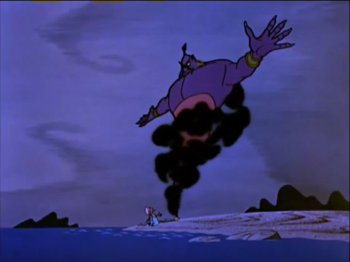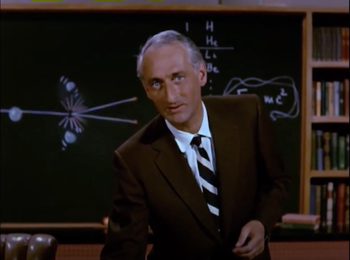Science, Magic, and the Atom in Tomorrowland
Atomic power as both a malevolent and benevolent force, as well as Orientalist caricature.
It is January 1957, ten months before the launch of Sputnik. American television viewers tune into ABC network for the latest episode of the Disneyland weekly program (later known as The Wonderful World of Disney). About halfway through the hour-long program, viewers encounter an unsettling sight: test footage from a nuclear weapon detonation. Even worse, a gargantuan animated figure emerges from the mushroom cloud. Only his head and torso are visible. The rest of his body dissolves into the cloud, making him appear as an extension of this horrifying phenomenon. He looks down disdainfully at the world below him and folds his arms in an intimidating posture. He disappears, followed by footage of several more test detonations. A few minutes later, viewers see an animated drawing of a nuclear reactor building. The giant reappears in a cloud of his own making. He again looks around, but this time, he looks straight ahead and bows to the adults and children in living rooms around the country. Who is this strange supernatural being? He is the atomic genie, who will master us if we do not master him.
This 1957 episode, known as “Our Friend the Atom,” brings together a primer on atomic physics with an apologia for the so-called “peaceful uses of atomic energy” championed by the American nuclear state. It is a mix of animated and live action segments hosted by Heinz Haber, a former Nazi scientist and American aerospace consultant. Central to the episode is an allegorical tale borrowed from The Thousand and One Nights, more commonly known as the Arabian Nights. Haber narrates an animated retelling of “The Fisherman and the Genie,” wherein an unwitting fisherman snares a mysterious oil lamp in his nets. Examining his catch, he releases a powerful genie trapped in the lamp. The genie intends to destroy him, but the fisherman dares him to prove his power by fitting back into the lamp. Now tricked back into his prison, the genie gains his freedom only by offering to grant three wishes. Haber explains that humanity has found its own genie of incredible power—an atomic genie—locked away in substances like uranium and radium. By splitting the atom, scientists have released the powerful genie from its confinement. Although the atom has the power to destroy, humans have established their mastery and forced it to grant wishes.
One could view “Our Friend the Atom” simply as heavy-handed Cold War propaganda, but such an analysis would be incomplete. Further, it would also be easy, at first glance, to attribute the use of The Thousand and One Nights to a legacy of cultural appropriation and insensitivity by the Walt Disney Company. Of course, much of the animation is exoticizing and racist, but there is a level of appropriation that long predates Disney. The Arabian Nights was the product of a colonial gaze that imagined “Arab culture” as a uniform and undifferentiated Other. The collection known to Europeans and Americans was first published in a 1704 edition by French scholar and antiquarian, Antoine Galland. That compilation, in turn, was assembled from a fifteenth-century Syrian manuscript entitled A Thousand Nights and One Night, an assortment of other tales composed in Arabic, and a collection of stories told to Galland by Aleppine merchant Hanna Diyab. So, what else is going on in Disneyland? Well, it is a magical tale in more ways than one.
“Our Friend the Atom” celebrates nuclear physics and engineering by hearkening back to a supposedly prescientific age of magic and superstition. This juxtaposition is not as unusual or contradictory as it sounds. For well over a century, scholars have shown that the history of knowledge creation was never neatly divided between the “scientific” and the “superstitious.” That false binary only serves to promote genealogies of progressive enlightenment. Postcolonial scholar David L. Martin refers to this ironing out of the past as a “homogenizing strategy.” Like only goes with like, and magic died so science could thrive. Martin turns that notion on its head: “Although scientific rationality would come to define its knowledge claims against a series of heterogeneous elements decried as mere superstitious irrationality . . . such was not the case.” Within the epistemic and material conditions of modernity, the labeling of something as irrational or pseudoscientific became a power move. And, before I am charged with being “anti-science” or supporting an “alternative facts” free-for-all, let me clarify. Martin’s “heterogeneity” is not a call to abandon critical inquiry or healthy skepticism. Rather, it is a reminder that authority and expertise require including certain things and excluding others, and we can learn much by asking what is missing and why it was excluded. Or, is it there and merely concealed?
Disney’s retelling of “The Fisherman and the Genie” from One Thousand and One Nights. In this atomic version, the narrator tells us that the lamp is closed with a lead stopper, rather than a magical seal.
Speaking of concealment, Disney’s atom acts as an all-powerful sentient being, radioisotopes resemble the magical dust of Tinkerbell, and atomic energy emerges as the ultimate transmutation of matter that can lead to limitless health and wealth. One could say that Disney was building on its strengths, since the studio was conjuring the magical milieu that made its animated films such smashing successes. One could also say that Disney wanted to honor the dreams of millennia of thinkers and makers and tinkerers who sought knowledge of the world, no matter what they called themselves. In other words, it was a midcentury version of the meme: “Science is magic that’s real.” Both interpretations have great merit and are worth further consideration. However, I also think sinister forces are at work here.
Heinz Haber: physicist, program host, and…former Nazi.
“Our Friend the Atom” makes the fisherman the hero of the story, while the atom serves first as fearsome foe and then as obedient servant. The viewer is thus persuaded to sympathize with the human (i.e., the nuclear-industrial state) and fear the power of the atom (i.e., what the nuclear-industrial state wants to have and use). Abracadabra! The people in charge of atomic fission gain trust because, they have power over the greatest power of all. Ingenious, is it not? The magic most at work is the sleight-of-hand from stage magic that directs attention elsewhere to distract from what is actually happening: anthropomorphizing the atom transfers moral responsibility for atomic energy from the American nuclear state to a seemingly sentient infinitesimal particle.
It is worth noting that Disney could have chosen from a number of stories about humans and extraordinary power. The studio had famously adapted Goethe’s 1797 poem “The Sorcerer’s Apprentice” for its 1940 feature film Fantasia. Other candidates could include the Golem of Prague, Doctor Faust, or Victor Frankenstein. The downside is that all of these tales are tragic and cautionary. The use of power threatens or destroys the creators. The tale of the fisherman can be told as one of optimism and triumph, and that is the interpretation that Disney animators chose.
Yet, several years earlier, esteemed Cold War scientist Norbert Wiener drew an entirely different conclusion. His landmark book on cybernetics, The Human Use of Human Beings, included dire warnings about the misuse of power and the disastrous consequences that could follow. Referencing the fisherman’s tale, Wiener wrote, “When a djinnee is found in a bottle, it had better be left there.” Even more to the point, he found those in control of technoscience to be no wiser than Mickey Mouse wearing a sorcerer’s hat: “We may say that among the gentlemen who have made it their business to be our mentors, and who administer the new program of science, many are nothing more than apprentice sorcerers, fascinated with the incantation which starts a devilment that they are totally unable to stop.”
Christopher Fite is a Doctoral Candidate in the History and Sociology of Science at the University of Pennsylvania.



